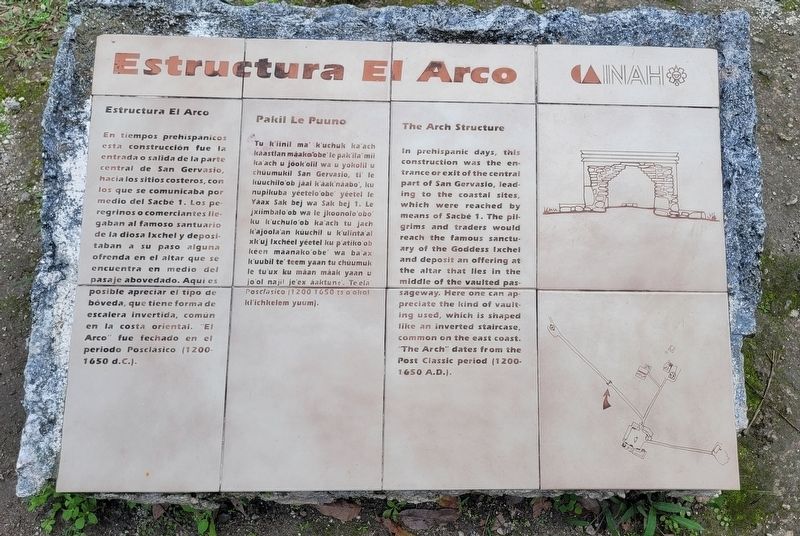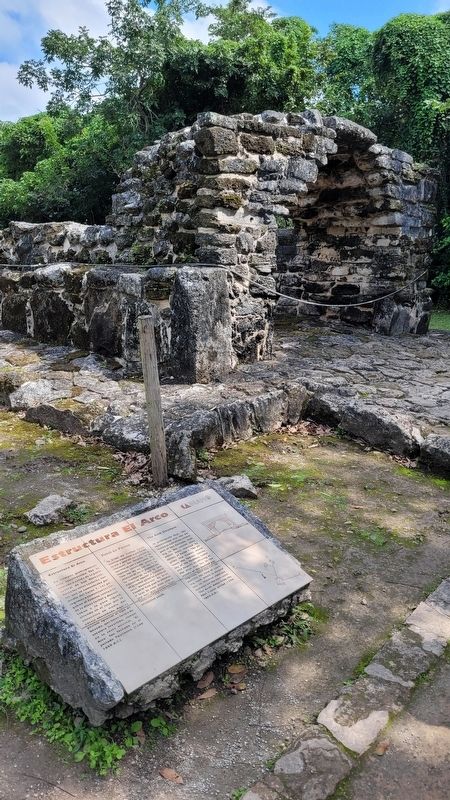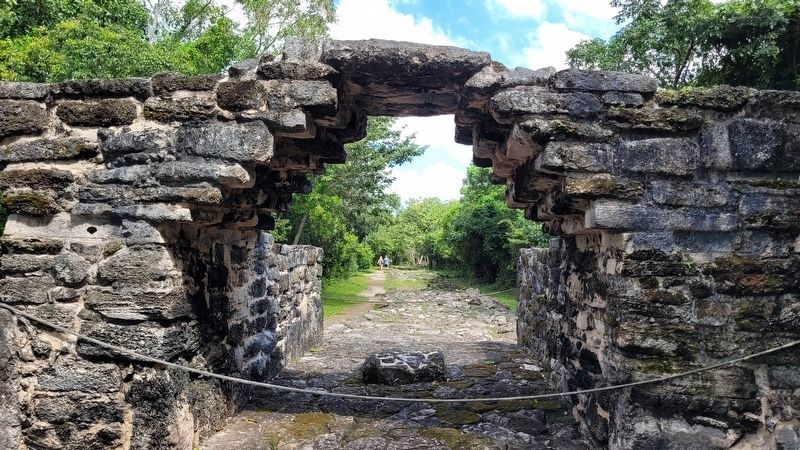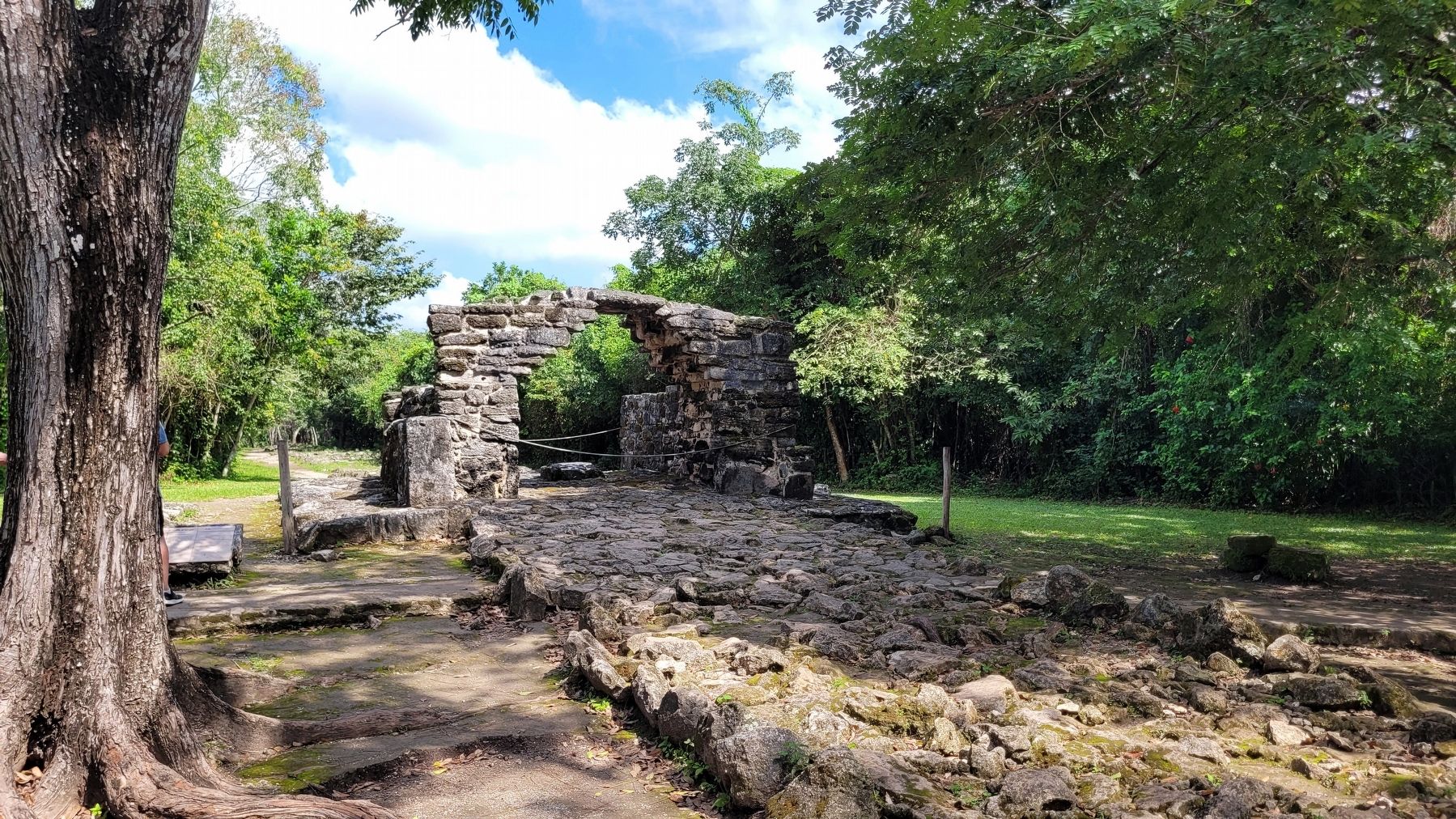Near San Miguel de Cozumel in Cozumel, Quintana Roo, Mexico — The Yucatan Peninsula (The Southeast)
Estructura El Arco / The Arch Structure
En tiempos prehispánicos esta construcción fue la entrada o salida de la parte central de San Gervasio, hacia los sitios costeros, con los que se comunicaba por medio del Sacbé 1. Los peregrinos o comerciantes llegaban al famoso santuario de la diosa Ixchel y depositaban a su paso alguna ofrenda en el altar que se encuentra en medio del pasaje abovedado. Aqui es posible apreciar el tipo de bóveda, que tiene forma de escalera invertida, común en la costa oriental. "El Arco" fue fechado en el periodo Posclásico (1200-1650 d.C.).
Mayan:
Pakil Le Puuno
Tu k'iinil ma' k'uchuk ka'ach káastlan maako obe' le pak'ila' mii ka'ach u jook'olil wa u yokolil u chúumukil San Gervasio, ti' le kuuchilo ob jáal k'áak'náabo', ku nupikuba yéetelo'obe' yéetel le Yaax Sak bej wa Sak bej 1. Le jxiimbalo'ob wa le jkoonolo'obo' ku k'uchulo'ob ka'ach tu jach k'ajoola'an kuuchil u k'ulinta'al xk'uj Ixchéel yéetel ku p'atiko'ob kéen máanako'obe' wa ba'ax k'uubil te' teem yaan tu chúumuk le tu'ux ku maan maak yaan u jo'ol najil je'ex áaktune'. Te'ela Posclasico (1200 1650 ts'o'okol ki'ichkelem yuum).
The Arch Structure
In prehispanic days, this construction was the entrance or exit of the central part of San Gervasio, leading to the coastal sites, which were reached by means of Sacbé 1. The pilgrims and traders would reach the famous sanctuary of the Goddess Ixchel and deposit an offering at the altar that lies in the middle of the vaulted passageway. Here one can appreciate the kind of vaulting used, which is shaped like an inverted staircase, common on the east coast. "The Arch" dates from the Post Classic period (1200- 1650 A.D.).
Erected by Instituto Nacional de Antropología e Historia (INAH).
Topics. This historical marker is listed in these topic lists: Anthropology & Archaeology • Architecture • Native Americans. A significant historical year for this entry is 1650.
Location. 20° 30.032′ N, 86° 50.729′ W. Marker is near San Miguel de Cozumel, Quintana Roo, in Cozumel. Marker can be reached from San Gabriel Road, 6 kilometers east of Tran. de Cozumel. The marker is located at the northern section of the Zona Arqueológica San Gervasio. Touch for map. Marker is in this post office area: San Miguel de Cozumel QR 77684, Mexico. Touch for directions.
Other nearby markers. At least 8 other markers are within walking distance of this marker. Estructuras 31 y 32 / Structures 31 & 32 (within shouting distance of this marker); Estructura Las Columnas / The Columns Structure (about 90 meters away, measured in a direct line); Estructura El Altar / The Altar Structure (about 90 meters away); Estructura Los Nichos / The Niches Structure (about 90 meters away); Estructura 25 B / Structure 25 B (about 120 meters away); Estructura El Alamo / The Alamo Structure (about 120 meters away); Estructura Los Murales / The Murals Structure (about 120 meters away); Estructura El Osario / The Ossuary Structure (about 120 meters away). Touch for a list and map of all markers in San Miguel de Cozumel.
Also see . . . San Gervasio (Maya site). Wikipedia
San Gervasio is an archaeological site of the pre-Columbian Maya civilization, located in the northern third of the island of Cozumel off the northeastern coast of the Yucatán Peninsula, in what is now the Mexican state of Quintana Roo. San Gervasio's pre-Hispanic name was Tantun Cuzamil, Mayan for Flat Rock in the place of the Swallows. The ruins were once a hub of worship of the goddess Ix Chel, an aged deity of childbirth, fertility, medicine, and weaving. Pre-Columbian Maya women would try to travel to San Gervasio and make offerings at least once in their lives.(Submitted on July 8, 2023, by James Hulse of Medina, Texas.)
Credits. This page was last revised on July 12, 2023. It was originally submitted on July 8, 2023, by James Hulse of Medina, Texas. This page has been viewed 46 times since then and 11 times this year. Photos: 1, 2, 3, 4. submitted on July 8, 2023, by James Hulse of Medina, Texas.



